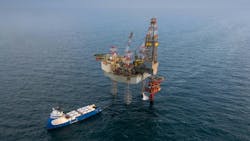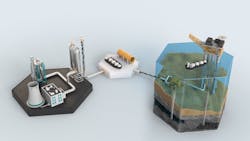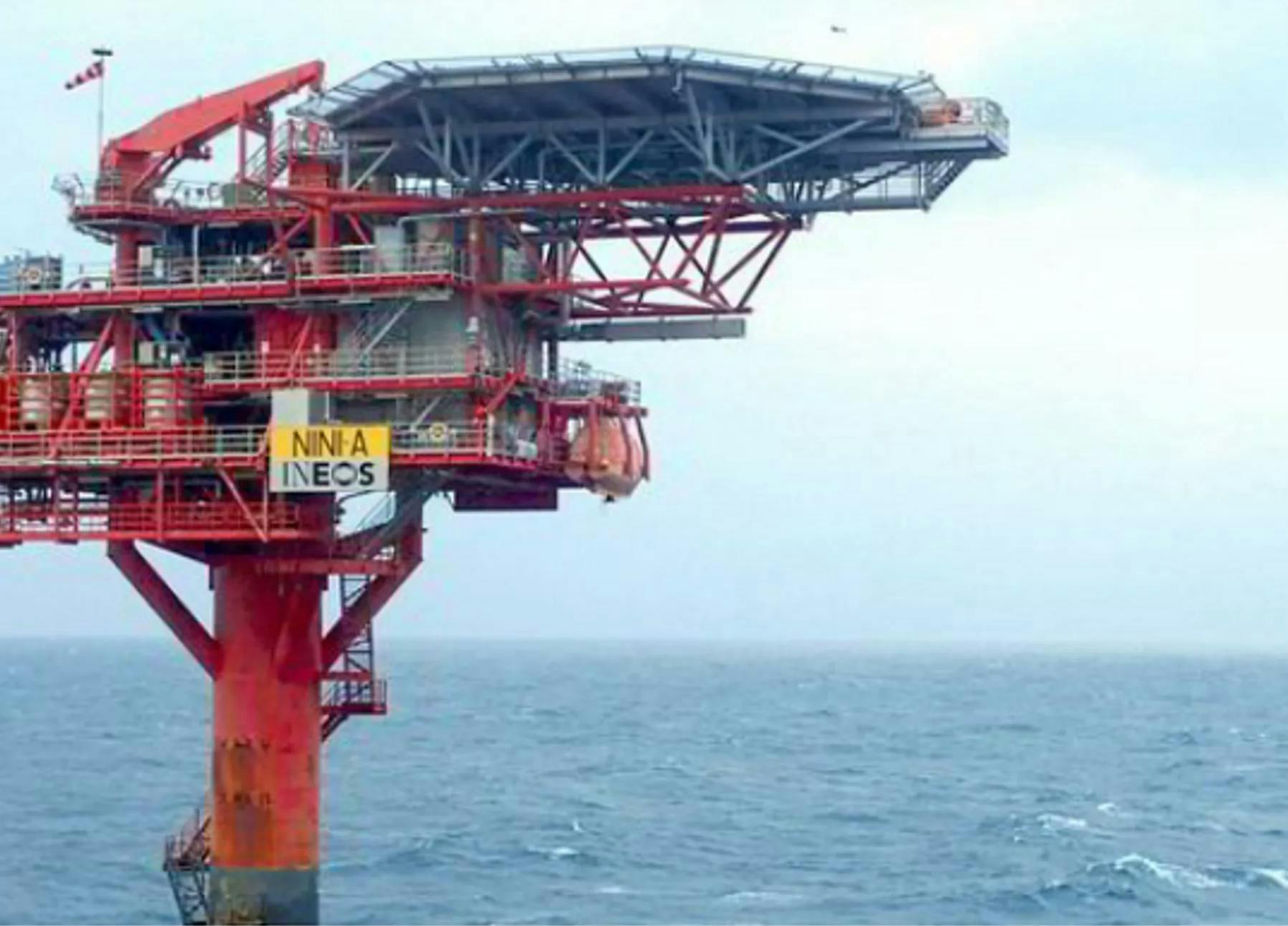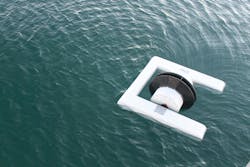Offshore groups investigate safety measures for drilling into CO2 reservoirs
Editor's note: This feature first appeared in the May-June 2024 issue of Offshore magazine. Click here to view the full issue.
By Jeremy Beckman, Editor-Europe
Full-scale carbon capture and storage (CCS) developments are set to go forward over the next few years across the North Sea region, offshore Australia and Southeast Asia and along the US Gulf Coast. Conventional rigs will likely drill the initial sets of wells into the saline aquifers or depleted reservoirs that will receive the CO2 transported from industrial emitters onshore. But the next phase of drilling, into reservoirs already storing large CO2 volumes, represents something of a leap into the unknown.
According to Noble Corp., well control issues could arise during drilling or workover of wells for use as CO2 injectors. “CO2 will oftentimes be pumped and stored in a super-critical condition where it takes on properties in between a gas and a liquid,” said the company’s Senior Business Developer Zach Bruton. “Detecting and managing this could prove difficult should a CO2 influx enter the well. And if a well control incident did occur, the gas circulated up the annulus would likely expand more significantly than a hydrocarbon kick.”
Operators and service companies are also working to determine which existing offshore oil and gas wells could safely be prepared for re-use, and which would need remediation to ensure suitability for long-term CO2 injection. The REX-CO2 project in Europe has developed a screening process for existing wells that includes re-use without modification; workover with modification; side-tracking from a portion of the well; deepening the wellbore to access a deeper target; partial plugging of sections of the well; and re-entry of an abandoned well. The project’s accompanying software addresses key issues such as structural, primary and secondary well barrier integrity; material compatibility; and the risk of out-of-zone injection.
Among drilling contractors, Noble has been one of the early movers in assessing the likely scenarios for safe well construction in CO2-rich reservoirs offshore. The company deployed the jackup Noble Resolve for the current CO2 injection pilot for Project Greensand in the Danish North Sea, led by Ineos and Wintershall Dea. Here, liquidized CO2 captured and transported from the Ineos Oxide factory in Belgium is injected via a well into the Nini West sandstone reservoir, 1,800 m (5,905 ft) below the seabed, for permanent storage.
Noble has also been collaborating with DNV and bp, as leader of the Northern Endurance Partnership in the UK, on the new CCS-Enabled Rig Design for drilling/workover operations in a CO2-rich environment. NEP, formed in 2020, will transport CO2 captured from industries within the East Coast Cluster in north-east England for injection 145 km (90 mi) offshore the Teesside coast into the Endurance saline aquifer. This is thought to hold storage capacity for 450 MM metric tons of CO2, with other subsurface stores nearby potentially raising capacity to 1 billion metric tons.
The International Energy Association estimates that more than 50 MMt/yr of CO2 is being injected globally at present with increasing numbers of wells to be drilled post-2030 as the planned rate soars to 1,200 MMt/yr. But as bp noted in its planning for Endurance CCS, until now no MODUs have been certified for drilling into CO2-rich reservoirs, and conventional mobile rigs are not configured for operations in a pure CO2 environment. The properties of CO2, bp and others realized, might require modifications or changes to existing rig equipment, processes and procedures. Those concerns led to the development of a qualification program to prepare Noble’s rigs for safe drilling into CO2 reservoirs.
For the CO2 rig project, the main goal was to define generic requirements for qualifying an offshore rig to be ready for CO2 drilling operations, using Noble Resolve as a base case. The program drew on DNV’s experience in CO2 risk management, bp’s track record in CO2 injection for enhanced oil recovery, and Noble’s feedback from participation in Project Greensand. According to Zach Bruton, “this allowed subject matter specialists to assess the equipment upgrades, rig and management system modifications needed for drilling operations with a risk of encountering a high- CO2 concentration event, along with procedural updates, training and PPE requirements.”
The partnership prioritized technical solutions to address material exposure to very low temperatures, and mitigation measures for CO2 influx detection. Noble highlights four main challenges when drilling into a CO2-rich reservoir:
- Cold – when CO2 is forced through a valve such as in the choke line it can expand rapidly. This causes its temperature to drop (Joule-Thomson effect), potentially damaging piping or leading to formation of hydrates
- Heavier than air: circulated CO2 settles downwards instead of rising upwards like natural gas. This means new vent lines will be needed and other systems to ensure the crew’s safety
- Toxicity – CO2 is hazardous to individuals at concentrations above 5%, so portable CO2 detectors, personal gas masks and extra oxygen for rescue teams should be considered
- CO2 and its compounds are corrosive, damaging steel, plastic and elastomers when in contact too long. Its solubility in oil brings a (very low) risk of uncontrolled blowout. Finally, methane CO2 is flammable.
To devise practical recommendations, Bruton explained, “the project team studied hypothetical cases based on planned CCS operations. Focus areas included dispersion analyses, modelling venting of a CO2 kick on board, and tests of well control equipment for embrittlement, corrosion, and temperature impacts in the presence of CO2. The work followed the DNV Recommended Practice-RP-A203 for Technology Qualification. In 2023, initial phases of technology qualification were completed, along with technology and threat assessment. Then followed equipment testing, providing the basis for completing full equipment and management systems recommendations in 2Q 2024.
“During the first half of this year, Noble has conducted material testing including cryogenic tests, of key well control items. We have identified critical wells control equipment and materials and have performed laboratory type testing with exposure to CO2. A selection of rubber and critical steel materials has been undergoing testing. We are also in dialogue with OEMs regarding the well control equipment and materials to find a safe, operational and cost-effective solution for the CCS Enabled Rig Design.”
Noble has identified up to 10 North Sea CCS projects as potentially suited to its jackup fleet: these projects, it calculates, will require up to 45 injection wells pre-2030, covering new CO2 injectors and workovers of legacy wells. Among the probable developments are Project Greensand, where the partners expect to take FID later this year on a second-phase program that would involve storing up to 1.5 MMt of CO2/yr in 2025-26 via the Nini platform and a new dedicated well into the sandstone reservoir.
“For Phase 1,” said Jens Hedegaard, Head of CCS, “Noble was initially responsible for developing the well engineering package, which included legacy well integrity risk assessment; well abandonment risk assessment and time/cost estimates; casing design for slot recovery and re-drill; and a time and cost summary for the completion design. Using the Noble Resolve, a successful CO2 injection demonstration project was then conducted. Following this, Noble became the preferred drilling contractor for subsequent phases until 2028.
“At Project Greensand the client will assess whether we can repurpose existing wells or will need to drill new ones. The client will also decide which rig is used for the second phase program.”
In Norway, the Equinor-led Northern Lights project, the first CCS development in the North Sea, should be ready to start receiving and injecting first shipments of CO2 this year. The initial capacity will be 1.5 MM mt/yr of CO2, with plans to increase the storage capacity to a minimum of 5 MMt/yr under the next development phase. Planning has now started on other CCS projects elsewhere in the Norwegian sector, with the government favoring saline aquifers in the North Sea acreage it has so far made available. Noble has presented its learnings for future drilling in CO2 environments to Havtil (the Norwegian Ocean Industry Authority).
“We have been approachable and open to sharing our technical qualification work and some of our findings thus far,” said Hedegaard. “As for wider certification requirements for CCS drilling, the company is participating in standard discussions and also holding talks with class authorities and national authorities.”
Recently Noble joined Project Green Light, an R&D initiative that is developing software to support safe well construction in the presence of CO2 plumes. “The overall aim is to develop the comprehensive analysis/knowledge, and corresponding solution needed for full-scale CO2 storage to prevent subsurface leakage,” said Bruton. “The well control technology for CCS will be designed to mitigate these risks, allowing safe and efficient drilling in established CO2 storage sites. Noble is contributing experience and learnings from its CO2 Certified Rig project [the new name for the CCS-Enabled Design following the recent qualification exercise]; eDrilling is developing the well control software requirements.”
This month, Noble will also embark on a simulation exercise with Houston-based Endeavor Technologies, modelling the challenges of super critical CO2 downhole in various well control scenarios, in co-operation with an operator and a standards agency. Endeavor has pioneered accelerated simulation computing to solve oil and gas calculations in real-time. Its software engine calculates mass amounts of data in real-time, allowing modelling of complex scenarios, and dynamically calculating change of flow paths and property changes on surface or downhole.
About the Author
Jeremy Beckman
Editor, Europe
Jeremy Beckman has been Editor Europe, Offshore since 1992. Prior to joining Offshore he was a freelance journalist for eight years, working for a variety of electronics, computing and scientific journals in the UK. He regularly writes news columns on trends and events both in the NW Europe offshore region and globally. He also writes features on developments and technology in exploration and production.




